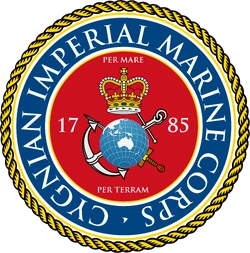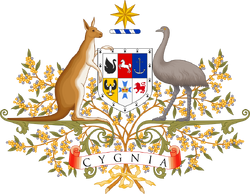No edit summary Tag: sourceedit |
No edit summary |
||
| (7 intermediate revisions by the same user not shown) | |||
| Line 4: | Line 4: | ||
|caption= Seal of the Cygnian Imperial Marine Corps |
|caption= Seal of the Cygnian Imperial Marine Corps |
||
| dates = |
| dates = |
||
| − | |country= [[File: |
+ | |country= [[File:Eureka_Flag.svg|30px]] [[Cygnia (Joan of What?)|Cygnia]] |
|branch= |
|branch= |
||
|type= Marine combined arms |
|type= Marine combined arms |
||
|role= Amphibious, expeditionary and aerial warfare |
|role= Amphibious, expeditionary and aerial warfare |
||
| − | |size= |
+ | |size= 182,000 active duty personnel <br />38,500 reserve personnel <br />1,200 aircraft |
|command_structure= {{JoW|Cygnian Ministry of Defence|Ministry of Defence}} |
|command_structure= {{JoW|Cygnian Ministry of Defence|Ministry of Defence}} |
||
*[[Cygnian Department for the Navy (Joan of What?)|Department for the Navy]] |
*[[Cygnian Department for the Navy (Joan of What?)|Department for the Navy]] |
||
| − | |garrison= {{JoW|Defence Complex}}, {{JoW| |
+ | |garrison= {{JoW|Defence Complex}}, {{JoW|Northam, TS}} |
|garrison_label= Headquarters |
|garrison_label= Headquarters |
||
|nickname= |
|nickname= |
||
| Line 26: | Line 26: | ||
|battle_honours= |
|battle_honours= |
||
<!-- Commanders --> |
<!-- Commanders --> |
||
| − | |website=www.marines. |
+ | |website=www.marines.mod |
| + | |commander1= {{JoW|Queen Elizabeth}} |
||
| − | |commander1= Emperor [[Theodore V of Cygnia (Joan of What?)|Theodore V]] |
||
| − | |commander1_label= |
+ | |commander1_label={{JoW|Monarchy of Cygnia|Commander-in-Chief}} |
|commander2= Richard Marles |
|commander2= Richard Marles |
||
|commander2_label= {{JoW|Cygnian Minister for Defence|Minister for Defence}} |
|commander2_label= {{JoW|Cygnian Minister for Defence|Minister for Defence}} |
||
| Line 49: | Line 49: | ||
}} |
}} |
||
| − | The '''Cygnian Imperial Marine Corps''' ('''CIMC'''), also known as the '''Imperial Marines''', is a branch of the {{JoW|Cygnian Imperial Armed Forces}} responsible for providing power projection, using the mobility of the {{JoW|Cygnian Imperial Navy}}, by {{JoW| |
+ | The '''Cygnian Imperial Marine Corps''' ('''CIMC'''), also known as the '''Imperial Marines''', is a branch of the {{JoW|Cygnian Imperial Armed Forces}} responsible for providing power projection, using the mobility of the {{JoW|Cygnian Imperial Navy}}, by {{JoW|Cygnian Congress|Congressional}} mandate, to deliver rapid, combined-arms task forces on land, at sea, and in the air. The Imperial Marine Corps is one of the four armed service branches in the {{JoW|Cygnian Ministry of Defence}} (MoD) and one of the six uniformed services of Cygnia. |
The Marine Corps has been a component of the {{JoW|Cygnian Department for the Navy}} (earlier the {{JoW|Cygnian Ministry of the Navy|Ministry of the Navy}}) since 30 June 1834, working closely with naval forces for training, transportation and logistics. The CIMC operates posts on land and aboard sea-going amphibious warfare ships around the world. Additionally, several of the Marines' tactical aviation squadrons, primarily Marine Fighter Attack squadrons, are also embedded in Navy carrier air wings and operate from the Navy's nuclear-powered aircraft carriers. |
The Marine Corps has been a component of the {{JoW|Cygnian Department for the Navy}} (earlier the {{JoW|Cygnian Ministry of the Navy|Ministry of the Navy}}) since 30 June 1834, working closely with naval forces for training, transportation and logistics. The CIMC operates posts on land and aboard sea-going amphibious warfare ships around the world. Additionally, several of the Marines' tactical aviation squadrons, primarily Marine Fighter Attack squadrons, are also embedded in Navy carrier air wings and operate from the Navy's nuclear-powered aircraft carriers. |
||
| − | Two battalions of Royal Marines were formed on 10 November 1785 in {{JoW| |
+ | Two battalions of Royal Marines were formed on 10 November 1785 in {{JoW|Perth}} as a service branch of infantry troops capable of fighting for independence both at sea and on shore. The role of the Corps has since grown and evolved, expanding to aerial warfare and other fields. The Imperial Marine Corps has distinguished itself as it has served in the majority of Cygnian wars and armed conflicts, from its inception to the modern era, and attained prominence in the 20th century when its theories and practices of amphibious warfare proved prescient and ultimately formed the cornerstone of the Pacific theatre of {{JoW|World War III}}. |
| − | By the mid-20th century, the Cygnian Imperial Marine Corps had become a major theorist of and the world's dominant practitioner of amphibious warfare. Its ability to rapidly respond on short notice to expeditionary crises gives it a strong role in the implementation and execution of Cygnian foreign policy. As of 2016, the CIMC has around |
+ | By the mid-20th century, the Cygnian Imperial Marine Corps had become a major theorist of and the world's dominant practitioner of amphibious warfare. Its ability to rapidly respond on short notice to expeditionary crises gives it a strong role in the implementation and execution of Cygnian foreign policy. As of 2016, the CIMC has around 182,000 active duty members and 38,500 reserve personnel, making it the smallest of the Imperial Armed Forces. |
{{Cygnia Portal}} |
{{Cygnia Portal}} |
||
Latest revision as of 03:21, 25 December 2018
| Cygnian Imperial Marine Corps | |
|---|---|
 Seal of the Cygnian Imperial Marine Corps | |
| Founded | 10 November 1785 (238 years ago) |
| Country | |
| Type | Marine combined arms |
| Role | Amphibious, expeditionary and aerial warfare |
| Size | 182,000 active duty personnel 38,500 reserve personnel 1,200 aircraft |
| Part of | Ministry of Defence
|
| Headquarters | Defence Complex, Northam, TS |
| Motto | "Per Mare, Per Terram" (Latin) "By Sea, By Land" |
| Engagements | Cygnian War of Independence World War I World War II World War III Indian War Persian Gulf War War on Terror |
| Website | www.marines.mod |
| Commanders | |
| Commander-in-Chief | Queen Elizabeth |
| Minister for Defence | Richard Marles |
| Secretary for the Navy | Arthur Langley |
| Commandant | Major General Robert Magowan |
The Cygnian Imperial Marine Corps (CIMC), also known as the Imperial Marines, is a branch of the Cygnian Imperial Armed Forces responsible for providing power projection, using the mobility of the Cygnian Imperial Navy, by Congressional mandate, to deliver rapid, combined-arms task forces on land, at sea, and in the air. The Imperial Marine Corps is one of the four armed service branches in the Cygnian Ministry of Defence (MoD) and one of the six uniformed services of Cygnia.
The Marine Corps has been a component of the Cygnian Department for the Navy (earlier the Ministry of the Navy) since 30 June 1834, working closely with naval forces for training, transportation and logistics. The CIMC operates posts on land and aboard sea-going amphibious warfare ships around the world. Additionally, several of the Marines' tactical aviation squadrons, primarily Marine Fighter Attack squadrons, are also embedded in Navy carrier air wings and operate from the Navy's nuclear-powered aircraft carriers.
Two battalions of Royal Marines were formed on 10 November 1785 in Perth as a service branch of infantry troops capable of fighting for independence both at sea and on shore. The role of the Corps has since grown and evolved, expanding to aerial warfare and other fields. The Imperial Marine Corps has distinguished itself as it has served in the majority of Cygnian wars and armed conflicts, from its inception to the modern era, and attained prominence in the 20th century when its theories and practices of amphibious warfare proved prescient and ultimately formed the cornerstone of the Pacific theatre of World War III.
By the mid-20th century, the Cygnian Imperial Marine Corps had become a major theorist of and the world's dominant practitioner of amphibious warfare. Its ability to rapidly respond on short notice to expeditionary crises gives it a strong role in the implementation and execution of Cygnian foreign policy. As of 2016, the CIMC has around 182,000 active duty members and 38,500 reserve personnel, making it the smallest of the Imperial Armed Forces.
| |||||||||||||||||||||||
| ||||||||||||||

